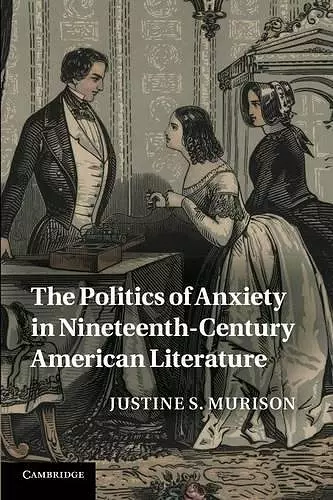The Politics of Anxiety in Nineteenth-Century American Literature
Format:Paperback
Publisher:Cambridge University Press
Published:19th Dec '13
Currently unavailable, and unfortunately no date known when it will be back

Murison explains the impact of neurological medicine on nineteenth-century literature and culture, particularly Hawthorne and Beecher Stowe.
New scientific discoveries about the nerves inspired writers like Hawthorne and Beecher Stowe to re-imagine the role of the self amidst political, social and religious tumults, including debates about slavery and the revivals of the Second Great Awakening. Murison explains the impact of neurological medicine on nineteenth-century literature and culture.For much of the nineteenth century, the nervous system was a medical mystery, inspiring scientific studies and exciting great public interest. Because of this widespread fascination, the nerves came to explain the means by which mind and body related to each other. By the 1830s, the nervous system helped Americans express the consequences on the body, and for society, of major historical changes. Literary writers, including Nathaniel Hawthorne and Harriet Beecher Stowe, used the nerves as a metaphor to re-imagine the role of the self amidst political, social and religious tumults, including debates about slavery and the revivals of the Second Great Awakening. Representing the 'romance' of the nervous system and its cultural impact thoughtfully and, at times, critically, the fictional experiments of this century helped construct and explore a neurological vision of the body and mind. Murison explains the impact of neurological medicine on nineteenth-century literature and culture.
"In this fascinating study, Justine Murison investigates the various discourses surrounding the workings of and roles played by the nervous system in nineteenth-century literature and culture. In the course of tracing circuits of exchange between body and mind, individual and surrounding environment, she calls attention to a variety of applications for new, oftentimes contested, understandings of physiological integrity and vulnerability in the era’s cultural, national, and political movements....Murison’s attention to “the role of embodiment in constructing social, historical, and most of all, fictional narratives” (p. 12) reflects the fact that her project is part of a very big, field-changing, post–“neuroscientific turn” (p. 175) methodological approach, and it’s exciting work to watch unfold." -Maura D’Amore, THE NEW ENGLAND QUARTERLY
ISBN: 9781107694149
Dimensions: 229mm x 152mm x 12mm
Weight: 310g
230 pages